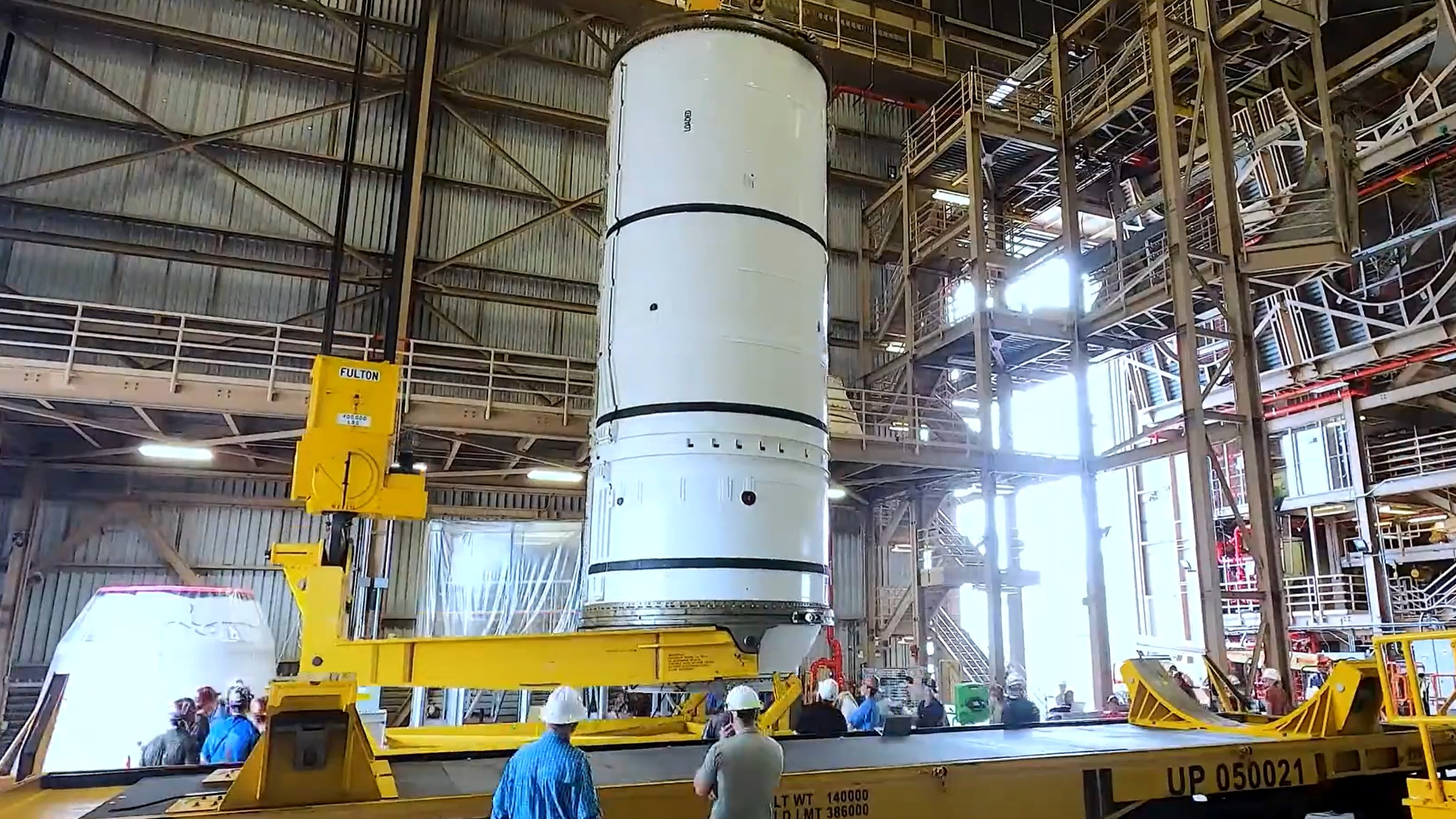
A new timelapse shows a moon rocket for astronauts under construction at NASA, ahead of the 2024 launch.
The twin rocket boosters for Artemis 2 will add oomph to NASA's powerful Space Launch System rocket, which will launch four astronauts on a mission to the moon in 2024. Each Northrop Grumman-made solid rocket booster weighs 1.6 million pounds (720,000 kg), which NASA officials have said is the equivalent mass of four blue whales.
The massive boosters arrived at NASA's Kennedy Space Center (KSC) by train in early October, following construction in Utah. Teams at KSC are now focusing on putting together parts of each booster's aft assembly – that's the part that steers the boosters as they're flying during a launch.
"Here, the left and right aft motor segments are mated to the aft skirts, which will be followed by the installation of the aft exit cones," NASA officials wrote Nov. 3 in a post on X, formerly Twitter.
Related: All aboard! Train tugs Artemis 2 moon rocket parts to the NASA launch center (photos, video)

As the new timelapse shows, moving these massive pieces around the KSC factory is no small matter. Each piece weighs roughly 150 tons or 150,000 kg, and their immense height also requires care. The two-story segments are between 26 to 33 feet (8 to 10 meters) high, depending on their position on the booster.
Technicians carefully move each booster segment using the facility's two 200-ton cranes, booster flow manager Heather Gillette said in an October Facebook livestream. After technicians position the cranes "on either side of the (booster) segment," she added, "they rotate it (the segment) from horizontal to vertical, and they move it over to our buildup stands."
Each booster will include five segments, once fully assembled. The design, incidentally, is based on the space shuttle program's booster — but is a little taller to support the larger SLS. Practically speaking, this means technicians will put five pieces on each SLS booster, instead of four pieces on the shuttle boosters.
Related: Watch fiery separation of NASA's Artemis 1 moon rocket boosters

The aft assembly work is underway at KSC's Rotation, Processing and Surge Facility while other booster pieces are in storage nearby. (The aft skirts were already at KSC before the other booster pieces arrived, as they were made at the center's Booster Fabrication Facility.)
Later, all booster segments – the fully assembled aft assemblies, and the segments awaiting construction – will move to NASA's iconic Vehicle Assembly Building at KSC. The rocket pieces will then see "further assembly atop the mobile launcher," or the big tower that supports SLS during launch.
The mobile launcher is otherwise occupied at the moment with essential testing at the Launch Pad 39A, from where the mission will launch to the moon. It recently underwent a water deluge test to examine the system that safely suppresses the powerful SLS and booster shockwaves during launch. The launch sound may unduly damage equipment otherwise.
All four astronauts are also busy with training to familiarize themselves with the Orion spacecraft, ahead of performing a splashdown simulation test with the U.S. Navy and NASA officials towards the end of 2023. After selection in April 2023, their training flow was scheduled to take about 18 months, meaning mission teams are formulating the procedures and hardware as the crew trains.
Artemis 2 will fly around the moon and back again to test Orion's systems ahead of an expected moon landing by Artemis 3 in 2025 or 2026. The astronaut quartet on board Artemis 2 includes NASA commander Reid Wiseman, NASA pilot Victor Glover, NASA mission specialist Christina Koch and Canadian Space Agency mission specialist Jeremy Hansen. Glover will become the first Black astronaut to venture beyond low Earth orbit, while Koch will be the first woman and Hansen the first Canadian.







